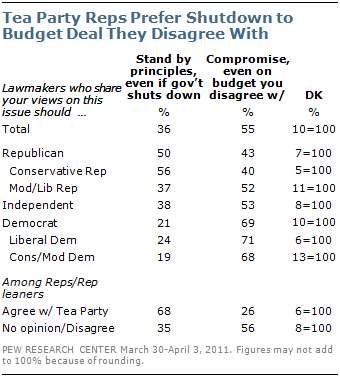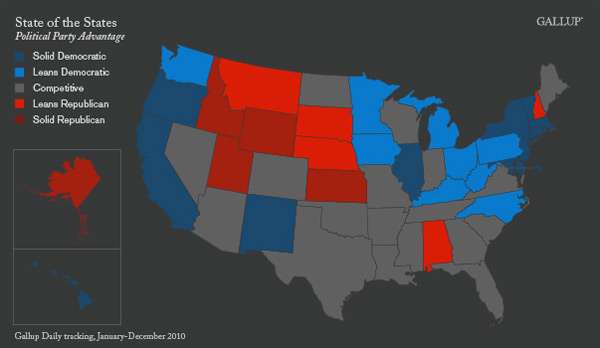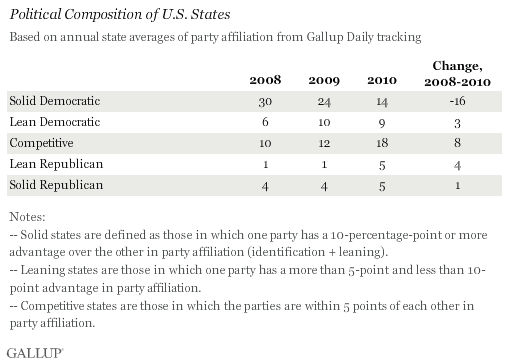-
Poll Watch: Americans Would Blame Obama and Republicans About Equally If Government Shuts Down

Kind of a lose-lose according to a Pew Research Center Poll.
With an April 8 deadline approaching for a possible shutdown of the federal government, the public remains divided over whether congressional Republicans or the Obama administration would be more to blame if a shutdown occurs.
Currently, 39% say Republicans would be more to blame if the two sides cannot agree on a budget and the government shuts down, 36% say the Obama administration, and 16% volunteer both sides.
These opinions are little changed from late February. However, opinions are far different now than they were during a similar dispute in 1995, shortly before the government did shut down. In November 1995, a few days before the government shut down, 46% said it would be mainly the Republicans’ fault while 27% said the Clinton administration would be more at fault, according to a Washington Post/ABC News survey.
The latest national survey by the Pew Research Center for the People & the Press, conducted March 30-April 3 among 1,507 adults, finds that most (55%) want the lawmakers they agree with on this issue to be more willing to compromise, even if it means they pass a budget they disagree with. Far fewer (36%) want the lawmakers they agree with to stand by their principles, even if it means the government shuts down.
President Obama is sponsoring a meeting tomorrow at the White House to supposedly work out a deal between Democrats and Republicans. However, the President is playing the mediator and not the leader, so who knows how this will turn out.
On the other hand, Tea Party House members, prefer to stand on principle rather than compromise. Here are the numbers:

So, what does it all mean?
President Obama’s deal had better be a good one or the government WILL shut down for a while on Saturday. There really is no RISK electorally to Tea Party conservative members of the House.
-
Poll Watch: 31% Approve of Republicans, 32% Approve of Democrats in Congress

Looks like equal disapproval in the latest Gallup Poll.As Congress attempts to come up with a budget agreement to avoid a government shutdown, Americans’ views of both parties in Congress are equally negative — 31% approve of the Republicans in Congress and 32% approve of the Democrats in Congress. Each party’s rating is among the lowest Gallup has found since the question was first asked in 1999.
American voters are not happy about the economy and the growth of government. They are taking it out on Congress and will take it out on President Obama if the economy and unemployment does not turn around.
Congress faces difficult challenges in trying to jump-start the economy while also reining in spending as Americans grow increasingly weary of the federal budget deficit. The difficulty of these tasks is compounded by divided party control of Congress, with Republicans in the majority in the House of Representatives and Democrats controlling the Senate. To date, Congress has struggled to find agreement on long-term budget solutions, opting instead for short-term agreements to avoid a government shutdown. Its ability to do so, particularly this week, with the looming April 8 deadline to pass a 2011 budget or a continuing resolution, could play a crucial role in determining whether Americans’ views of Congress improve or deteriorate.
-
Government Shutdown Poll Watch: 29% Blame Democrats Vs. 23% Republicans
Twenty-nine percent of likely voters would blame Democrats for a government shutdown, compared to 23 percent who would hold Republicans responsible, according to a new poll conducted for The Hill.
The results are surprising because most people blamed the GOP for the last government shutdown, which occurred during President Clinton’s first term. A week before the 1995 shuttering, polls showed the public blamed Republicans by a two-to-one-margin.
This is surprising to me but may speak to the difference as to how President Obama is perceived versus Bill Clinton. Bill Clinton always came off as a good ol’ boy POL who wold compromise if there was an advantage to him. Hence, the shutdown in 1995 was spun as a radical move by the GOP and Newt Gingrich.
Republicans have a substantial edge among independents: Thirty-four percent would blame Democrats, while only 19 percent would blame the GOP.
However, there are dangers for both parties, the poll indicates. A plurality of voters, 43 percent, would blame both Republicans and Democrats if the lights go out at midnight on March 5. Forty-five percent of respondents said neither party would benefit politically from a shutdown.
This compares to 14 percent who think Democrats would benefit and 18 percent who said Republicans would.
It is in both parties interest to NOT shut down the government.
I think the biggest winner though may very well be President Obama who would take the high road and slam the GOP. So, since Obama is not enjoying good poll ratings, the Republicans may wish to deny him a bump up with a stagnant or declining economy. They can always blame him and the Democrats without the turmoil of a government shutdown.
-
Poll Watch: Number of Solid Blue Democratic States Cut by Half from 2008 to 2010
 Good news for the GOP and America as the number of competitive states has increased.
Good news for the GOP and America as the number of competitive states has increased.Gallup’s analysis of party affiliation in the U.S. states shows a marked decline in the number of solidly Democratic states from 2008 (30) to 2010 (14). The number of politically competitive states increased over the same period, from 10 to 18, with more limited growth in the number of leaning or solidly Republican states.
Here is the chart:

A competitive electoral map means a better marketplace of political ideas.
Now, for California…….
-
Poll Watch: Democratic Party ID Drops – Tying Lowest in 22 Years

So says the Gallup Poll.In 2010, 31% of Americans identified as Democrats, down five percentage points from just two years ago and tied for the lowest annual average Gallup has measured in the last 22 years. While Democrats still outnumber Republicans by two points, the percentage identifying as independents increased to 38%, on the high end of what Gallup has measured in the last two decades.
The Gallup Daily tracking poll, initiated in 2008, shows similar party identification figures for 2010 — 32% Democratic, 28% Republican, and 37% independent. The tracking data also show the same trend toward declining Democratic identification coupled with greater increases among independents than Republicans.
I guess President Obma, Nancy Pelosi and Harry Reid have been good for one thing: Helping the Republican Party.
-
House Democrats Reject Obama-GOP Tax Cut Deal in Current Form
 Yes, the Democratic Party has suddenly become the “Party of No.”
Yes, the Democratic Party has suddenly become the “Party of No.”The House Democratic Caucus has voted to reject President Barack Obama’s tax deal with Republicans in its current form.
By voice vote, the rank and file Democrats passed a resolution Thursday that said the tax package should not come to the floor of the House for consideration. Rep. Peter DeFazio, D-Ore., introduced the resolution.
Said Rep. Lloyd Doggett, D-Texas: “If it’s take it or leave it, we’ll leave it.”
Rep. Jim McDermott, D-Wash., said “it’s a pretty clear message. We don’t like the bill.”
So, what happens if President Obama’s own party does not affirmatively act on the Obama-GOP compromise tax rate/cut bill by the end of the lameduck session next week?
Taxes will go up on January 1 for everyone.
Of course, the GOP which in January will control the majority in the House will quickly vote to change the tax rates as soon as the new Congress meets, but, this will take time, Senate action (which is always slow) and economic uncertainty will do nothing positive for America.
Will the far-left House Democrats of Speaker Nancy Pelosi prevail over their own President?
Stay tuned here and on Twitter ———->
-
Election 2010: Regional Polarization in GOP House Gains
 Larry Sabato’s map above pretty much shows it all.
Larry Sabato’s map above pretty much shows it all.Every red dot represents a Republican pick-up (66 in all). The three blue dots are the sum total of Democratic takeovers in GOP districts (Delaware-AL, Louisiana-2, and Hawaii-1). The net Republican gain appears to settling in at 63. Thirty-three states gave the GOP at least one additional seat.
The Election Day “wave” for the Republicans produced a bumper crop of 23 new seats in the South and Border States, where the GOP traditionally does well. This region accounted for more than a third of total Republican gains.
But the key to the Republican House takeover occurred in the North Central states through the industrial Midwest. Pennsylvania (5), Ohio (5), and most surprisingly, New York (6) and Illinois (4) joined Indiana (2), Maryland (1), Michigan (2), Minnesota (1), New Hampshire (2), and New Jersey (1) in shifting a regional total of 29 to the GOP.
A good deal of this is simply a restoration of the pre-2006 status quo. Republicans lost some previously safe seats in the Democratic years of 2006 and 2008, and what goes around, comes around.
The Democrats captured traditionally Republican Congressional seats in 2006 and 2008 because of one factor: displeasure with President George W. Bush. With Bush out of office, suddenly the GOP gains. Of course, Obama and his far left minions in the Congress helped push Democrats to the LEFT and made them vulnerable.
Has normalcy been restored with a regional polarization of political parties?
I would say yes with the national Democratic Party having become a two state (California and New York), and ethnic based party (African Americans, Jews and Latinos). -
Has the Democratic Party Become a Regional or Two State Party?

Graphic Courtesy of Smart PoliticsRemember the harangue of the LEFT after President Obama’s win in 2008 that the GOP was a regional minority party?Well, as I said at the time, this is NOT true, but have the Democrats with the recent election have continued the trend of being a New York and California party – a two state party. Looking at the table above, you would have to say the evidence is clear.
Despite losing six U.S. House seats in New York on November 2nd (with defeats in NY-01 and NY-25 still tentative), the Democratic Party nonetheless continues to be ever more a party of two coasts – with a particular emphasis on the Empire and Golden States.
A Smart Politics analysis of 81 election cycles dating back to 1850 finds that the Democratic Party is now comprised of a larger percentage of Californians and New Yorkers in the U.S. House than at any point since California joined the Union.
When the 112th Congress convenes in January, 28.1 percent of the Democratic caucus will hail from California (34 members) and New York (20 members).
What will this mean for the 2012 Presidential and Congressional elections?
Well, I don’t suppose too many campaign media dollars will be spent on statewide races in New York and California. And, any Presidential activity will be fundraising trips only.
It also means will be easier for the GOP to maintain its majority in the House and look at taking the majority in the U.S. Senate.
Now, New York and California still command a goodly number of Electoral College votes but Obama will have to win in the Midwest or he will be denied re-election.
Funny how political demographic perceptions change but really stay the same.
-
Election 2010: Record Voter Enthusiasm Favors GOP

And, how!Americans’ enthusiasm about voting exceeds the recent midterm election high set four years ago, with 50% of Americans and 53% of registered voters saying they are more enthusiastic than usual about voting in 2010.
These results are based on the USA Today/Gallup final 2010 pre-election poll, conducted Oct. 28-31.
The record level of overall enthusiasm is primarily the result of Republicans’ heightened excitement — 63% of Republicans (including Republican-leaning independents) say they are more enthusiastic than usual about voting. That not only greatly exceeds Democrats’ expressed enthusiasm this year, but also is substantially higher than what Gallup has measured for either party’s supporters on the eve of a midterm election.
The GOP is looking for substantial gains when voting ends today.
The high level of Republican enthusiasm has led to the largest gap in enthusiasm by party of any recent midterm elections, 19 percentage points. The prior highs were nine points in favor of the Democrats in 2006, and nine points in favor of the Republicans in 1994.
The party with the advantage in enthusiasm has won the greater share of the national congressional vote, and gained seats in the House, each election year since Gallup began tracking voter enthusiasm in 1994.

Stay tuned as I make my way out to Orange County, California for the California Republican Party event this evening featuring U.S. Senate candidate Carly Fiorina.
-
Election 2010: Republicans Appear Poised For A Big Win Tomorrow

Good news for America tomorrow.The final USA Today/Gallup measure of Americans’ voting intentions for Congress shows Republicans continuing to hold a substantial lead over Democrats among likely voters, a lead large enough to suggest that regardless of turnout, the Republicans will win more than the 40 seats needed to give them the majority in the U.S. House.
The results are from Gallup’s Oct. 28-31 survey of 1,539 likely voters. It finds 52% to 55% of likely voters preferring the Republican candidate and 40% to 42% for the Democratic candidate on the national generic ballot — depending on turnout assumptions. Gallup’s analysis of several indicators of voter turnout from the weekend poll suggests turnout will be slightly higher than in recent years, at 45%. This would give the Republicans a 55% to 40% lead on the generic ballot, with 5% undecided.
Republicans’ 15-point lead among likely voters contrasts with their 4-point lead, 48% to 44%, among registered voters, highlighting the importance of higher GOP turnout to the election outcome. This wide difference between the GOP’s margin among registered voters and its margin among likely voters is similar to the 2002 midterms, in which Democrats led by 5 points among all registered voters in Gallup’s final pre-election poll, while Republicans led by 6 points among likely voters — an 11-point gain.
These final estimates of the vote among registered and likely voters are consistent with Gallup polling since Sept. 23. Republicans have led by an average of 4 points among registered voters and by 16 points among a low-turnout estimate of likely voters since that time. Thus, while voter preferences could change in the final two days, perhaps resulting from Democrats’ final push to motivate their base to turn out, voter preferences appear to be quite settled in this final post-Labor Day phase of the campaign.
Looks like control of the House of Representatives will change tomorrow from Democrat to Republican with the ouster of Speaker Nancy Pelosi. U.S. Senate control may or not change depending upon the GOP wave and how pervasive it becomes. We may know later in the day tomorrow about the Senate as Washington State and California returns come in.
